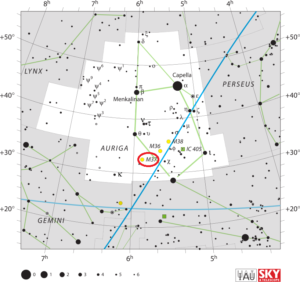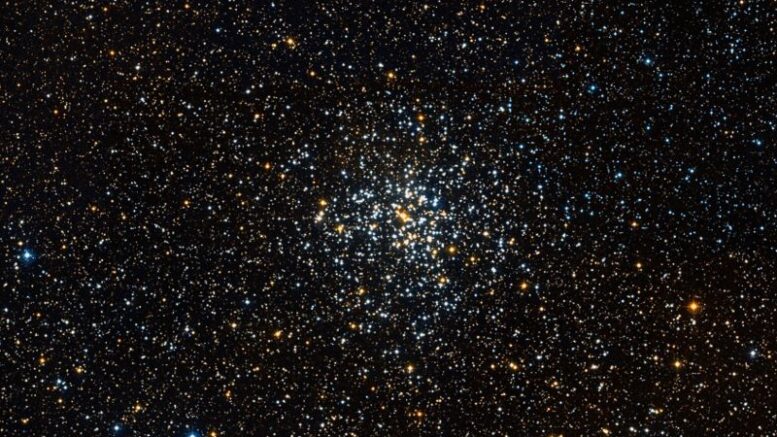Messier 37 is an open cluster in the constellation Auriga Messier 37 is the brightest, richest and largest of the three open clusters in this constellation that were catalogued by Messier. Interestingly, Messier 37 lies in the direction opposite to the galactic centre when seen from Earth.
| Description | |
| Visible From Pacific Northwest | October to March |
| Best Time To Observe | December |
| Minimum Size Of Viewing Device | 20×80 Binoculars |
| Object Type | Open Cluster |
| Designations | Messier 37, M37, NGC 2099, Collinder 75, C 0549+325, MWSC 0689 |
| Right Ascension | 5h 52m 18s |
| Declination | +32°33’02”+32°33’02” |
| Constellation | Auriga |
| Age | 346.7 to 550 million years |
| Apparent magnitude | +6.2 |
| Apparent dimensions | 24′ |
| Object Radius | 20 – 25 light years |
| Distance From Earth | 4,511 light years |
History
Messier 37 was discovered by the Italian astronomer Giovanni Battista Hodierna before 1654. Guillaume Le Gentil missed the cluster when he discovered the nearby Messier 36 and Messier 38 independently in 1749, even though M37 is brighter and larger than the other two objects.
Charles Messier discovered the cluster on September 2, 1764 and included it in his list of deep sky objects.
John Herschel catalogued the cluster as h 369 in 1827, describing it as a “very fine large cluster, all resolved into stars of 10th to 13th magnitude. It fills 1 1/2 field, but the straggling stars extend very far. There may be 500 stars.” Herschel later added the cluster to the General Catalogue as GC 1295.
Locating M33 In The Sky
Messier 37 can be found by first identifying the pentagon shape formed by the brightest stars in Auriga. The constellation lies in the northern sky, to the northeast of Taurus and northwest of Gemini.
Capella, the sixth brightest star in the sky marks the northern point of the polygon. To the east of Capella is Menkalinan (Beta Aurigae) and to the south of Menkalinan is Mahasim (Theta Aurigae). M37 lies east of the midpoint of the line drawn from Mahasim to Elnath in Taurus, which lies to the southwest. Being the easternmost of the three Messier clusters in Auriga, M37 is the only one found outside Auriga‘s pentagon asterism.

Viewing M37
In 10×50 binoculars, M37 appears as a hazy patch of light, but 20×80 and larger binoculars reveal a very compact star cluster, resolving the brightest stars. Small telescopes will show a dozen brightest stars, while 8-inch and larger instruments reveal several hundred stars in the cluster. The best time of year to observe Messier 37 is in the months of December, January and February.
Photographing M37
Photographing Messier 37 is one of the easier Messier objects as locating the object does not require utilizing an expensive camera nor hours of exposure.
It is indeed possible to capture M37 with as little as 1 hour or 2 hours of data with ISO 800. There are a plethora of options to use for imaging, as long as there is accurate guidance.
https://www.cloudynights.com/topic/86602-messier-37/
https://www.galactic-hunter.com/post/m37-open-cluster-in-auriga
Sources And Further Reading
Descriptions of all of Messier Objects can be found here.

Be the first to comment on "Messier 37"